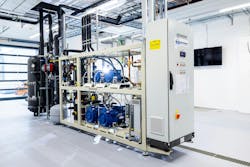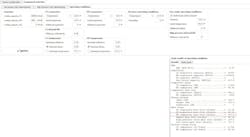Supermarket refrigeration systems have experienced large technology changes over the last decade, all linked to more efficient technologies being introduced to the industry. Arguably, the medium-temperature portion of the system has seen the largest changes.
The Shift to Variable-Speed
In one such example, it was not uncommon in older system designs for all compressors on the medium temperature suction group to be fixed-speed with simple on/off control. However, system design has evolved where almost all medium-temperature systems use either a variable frequency drive (VFD) or digital unloader modulation technology on the lead compressor of the suction group. This allows for more precise control of the suction pressure around the target setpoint by filling capacity gaps between each stage of the fixed-speed compressor. This maximizes efficiency by limiting energy consumption as it prevents undesired large compression ratios on low-pressure swings and also assists in maximizing the life span of the compressors by helping to ensure they do not operate outside of their designed compressor envelope.
Increased Adoption of CO2
Another example is linked to the industry shift to natural refrigerants. With natural refrigerants, specifically transcritical CO2 booster systems, becoming more common in the industry, the sizing, selection, and control of medium-temperature compressors has become increasingly important. Due to the design of booster systems, incorrect compressor selections or control can lead to problems not just with medium-temperature evaporators, but also with the low-temperature suction group and receiver pressure. If medium-temperature compressors are unable to maintain their design suction pressure due to poor staging, mechanical faults, or short-cycle timers, then the following scenarios will occur in a booster system:
- Low-temperature suction group discharge pressure will increase (since load goes to the medium-temperature suction line), which, in turn, will disable low-temperature compressors on high discharge pressure.
- Receiver pressure will increase, as this load is typically managed via a bypass valve shifting load to medium-temperature suction as receiver pressure increases above target. If receiver pressure continues to climb, it will eventually reach a threshold where CO2 is released to the atmosphere via a safety relief valve.
Further evolution of transcritical CO2 booster systems has made the accuracy of the medium-temperature compressor design even more important. Ejectors and parallel compression are two newer options to increase overall efficiency for a booster system by allowing load to be shifted away from medium-temperature compressors (via the ejector) and moved over to the receiver, where the refrigerant is then compressed using dedicated compressors (parallel compressors) operating at a smaller compression ratio. This is relevant to the sizing and selection of the medium-temperature compressors because a larger range of possibilities now must be considered.
On one hand, the medium-temperature compressors must be prepared for a full load where the ejector and parallel compressors are not operating. At the same time, they must be able to operate at part-load when the ejector and parallel compressors are operational. For example, system designers could accomplish this by going from a three-compressor suction group design to a four-compressor design, splitting the capacity of one compressor (i.e. 1x 20HP) into two separate compressors (i.e. 2x10HP) to better support the part-load scenario.
Figure 1 below is an example from a common software design tool that offers data to compare this particular design. In the Figure 1, a standard CO2 transcritical booster system (without parallel compression or ejector) is used. The medium-temperature compressor mass flow is calculated at 107.9 lb/min taking on all load from medium-temperature evaporators, the receiver, and the low-temperature suction group. In Figure 2, data is shown for a system with parallel compression and ejector with the same conditions. In this design, the expected medium-temperature compressor mass flow is only 37.38 lb/min, a reduction of 65%. Applying the same medium-temperature compressor selections for both designs would likely lead to poor performance in the second design, as relatively lower loads would not require the same amount of total capacity.


